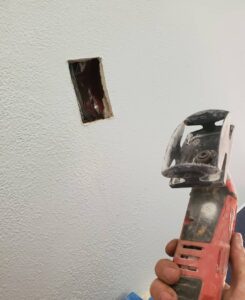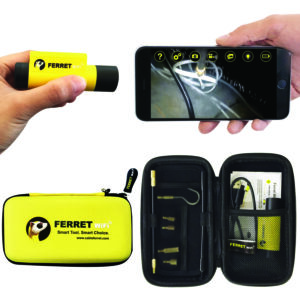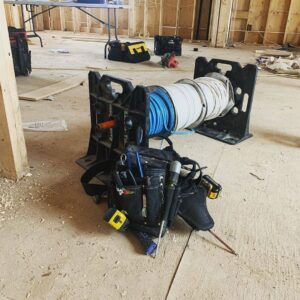The NEW Way to Install Pot Lights and Light Switches with Johnnie Johnson
Meet Johnnie Johnson. Johnnie has done all kinds of electrical work over the years but is always looking to learn and improve his craft. He has done a ton of residential work. From recessed lighting installation to branch circuits, and today he’s doing a reno on an old house without any knowledge of the circuitry or floor plans.

How to Find Studs
To prepare for the job, Johnnie starts by determining the position of the light fixtures, boxes, and receptacles. He also inspects the walls and ceilings for anything that would get in his way as he fishes his wires. He used to carry a basic stud finder to find studs and joists. Throughout the room, he would mark the stud locations with a pencil or tape. But this was a waste of tape, and clients didn’t like having their walls marked.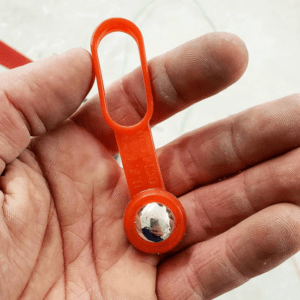 Nowadays on simple jobs like this, Johnnie uses the Stud Ball Magnetic Stud Finder from Rack-A-Tiers to find the screws or nails that secure the drywall to the studs. He’s able to let the ball hang in place for quick reference without having to mark his client’s walls like he used to. He has a few in his toolbox, and they work even better on the metal frames of commercial jobs.
Nowadays on simple jobs like this, Johnnie uses the Stud Ball Magnetic Stud Finder from Rack-A-Tiers to find the screws or nails that secure the drywall to the studs. He’s able to let the ball hang in place for quick reference without having to mark his client’s walls like he used to. He has a few in his toolbox, and they work even better on the metal frames of commercial jobs.
.
How to Measure & Align Recessed Lights
Another timewaster was marking all the cut-outs in the ceiling for the lights. Having to measure on a ladder with a tape measure was always sketchy, meaning he’d need to double-check every time. Now, once he finds the studs, he uses his Laser Plumb Bob to mark the locations of the recessed lights in the ceiling. The self-leveling tool shoots a laser up to the ceiling to provide pinpoint accurate measurements for your potlight holes. Laser Plumb Bob removes the guesswork and measurement mistakes. 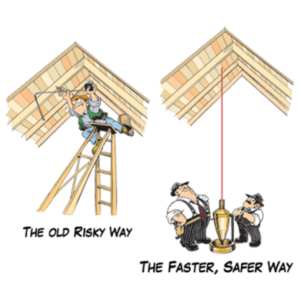
How to Cut Holes for Recessed Lights & Enclosure Boxes
Back when he was just an apprentice, he would cut holes for lights and boxes with just a drywall saw. He laughs now at how slow and sloppy that used to be, so messy and uneven. To make things worse, it was always difficult to contain the dust, and he had to waste more time on clean-up. 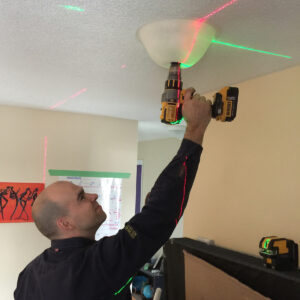 Now that he has been using all these Rack-A-Tiers tools, he makes sure to pack his Recessed Light Round Hole Saw with the Driller’s Dust Bowl, to make perfect 6 3/8” holes and keep the dust out of his face. Then he sets up the Q-bit Enclosure Hole Cutter on his multi-tool to cut a hole for the single gang device. The Dust Bowl does a fantastic job of collecting dust and debris while he’s drilling his holes, and he’s not mucking up his customer’s floors and furniture.
Now that he has been using all these Rack-A-Tiers tools, he makes sure to pack his Recessed Light Round Hole Saw with the Driller’s Dust Bowl, to make perfect 6 3/8” holes and keep the dust out of his face. Then he sets up the Q-bit Enclosure Hole Cutter on his multi-tool to cut a hole for the single gang device. The Dust Bowl does a fantastic job of collecting dust and debris while he’s drilling his holes, and he’s not mucking up his customer’s floors and furniture.
How to See Behind Walls
Johnnie used to dread fishing and pulling wire, especially through a finished ceiling with no visibility. It took ages to make sure the route was clear of other wires, pipes, or ceiling joists. Sometimes, the only choice he’d have would be to peek through his ceiling holes with a flashlight or feel around with a fish tape. Not having a helper to feed the wire for him sometimes lead to damaged wires and holes in walls.
Now he finally has the solution to working in the dark behind closed walls and ceilings. He has his trusty Head Light that lets him get a well-lit view above him and free up both hands. With his hands free he can use his Ferret Wi-Fi Inspection Camera and get a view during the fish. The Ferret pairs with his smartphone via Wi-Fi. It’s one of Johnnie’s favorite tools because it gives him a clear view in real-time without needing an access hole.
How to Fish & Pull Wire Through Walls
After getting to grips with his wire routes, Johnnie is ready to fish his NMSC cable. Back in the day, he would jimmy up a broomstick on a ladder to dispense his wire reels. Big pulls and the ladder would always be falling over. Now like a proper professional electrician, he has a Rack-A-Tiers Wire Dispenser that you can load up multiple reels and they are never falling over. To fish wire through the walls, he uses the Ferret cable fishing and pulling tool.
It’s a brand new type of fish tape with a more rigid construction and handy features like a guidewheel. Even Johnnie can’t believe how much easier the Ferret makes his job. 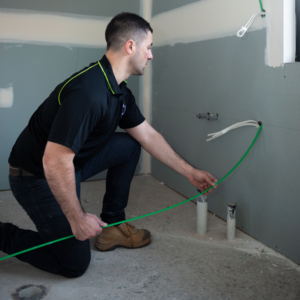
Learn from Johnnie!
Using Rack-A-Tiers’ amazing tools, Johnnie has transformed the way he works. With these tools in his toolbox, Johnnie is the electrician everyone wants on the job. He’s getting the job done faster, safer, and cleaner and we recommend trying them out yourself!
